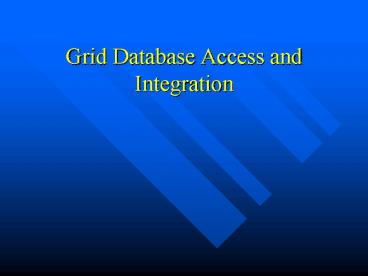Grid Database Access and Integration - PowerPoint PPT Presentation
1 / 24
Title:
Grid Database Access and Integration
Description:
The relationship between Grid database service and other Grid services. A Scenario ... Dependability:integrity, availability and security. Manageability ... – PowerPoint PPT presentation
Number of Views:26
Avg rating:3.0/5.0
Title: Grid Database Access and Integration
1
Grid Database Access and Integration
2
Aim to
- Requirement and potential functionalities of Grid
database Service - The relationship between Grid database service
and other Grid services
3
A Scenario
- Access an information service
- Select a service based on some criteria
- Authorized to use the service?
- Has access permissions on the data
- How much relevant data is available
- The way the data is stored and queried
- Formulate a request, and dispatch the request
4
Requirements for GDS(1)
- Data Sources and Resources
- Data Sourcesthe stream data in real time from
instruments and devices - Data resourcespersistent data stores in file or
DBMS - Virtual databasea logical set of data resources
5
Requirements for GDS(2)
- Data Structure and Representation
- Grid must support access to all types of data
- Numeric data
- Text data
- Multimedia data
- Binary format data
6
Requirements for GDS(3)
- Data Organisation
- Organisation types
- Application-specific file structures
- Held in DBMS(relational and object DBMSs)
- Held in XML repositories
- Data States
- Raw data
- Reference data
- Result data set
- Derived data setCreated from other existing data
7
Requirements for GDS(4)
- Provenance
- A record of the origin and history of the data
- The audit trail of the data
- Grid must provide the ability to record and
access data provenance
8
Requirements for GDS(5)
- Data Access Control
- Data owner can grant?revoke access permission,and
delegate authority - Requernment
- Flexiblecombinationsof restrictions and the
level of granularity - effectivegrantand revoke all types of
privileges dynamically - Easilyprovide facilities or tools to owners
9
Requirements for GDS(6)
- Data publishing and Discovery
- Challenge
- lack of agreed standards for structuring and
representing data - Lack of standards for describing published data
- Requenment
- Flexible
- Publish all types of data
- Discoveryname and location
10
Requirements for GDS(7)
- Data Publish Functionality
- Register and deregister data resources
dynamically - Schedule and propagate to site holding replicates
- Metadata definition, publication and
specification processed automated - Provide intelligent tools to process existing data
11
Requirements for GDS(8)
- Data Discovery Functionality
- Frame the discovery search criteria
- Defined naming conventions and ontologies
12
Requirements for GDS(9)
- Data Retrieval
- Translate metadata terms into physically
addressable data - Construct search rules and matching criteria from
the parameters - Link the relevant data resource
- Construct distributed queries, heterogeneous and
federated queries - Merge and aggregate data from different resource
to a single, logical set of result data
13
Requirements for GDS(10)
- Modes of Working with Data
- Background workingpredominant method for process
large volumes of data - Interactive working
- Data Management Operations
- Unlimited resources to create, process, analyse
- Unlimited volumes of data
14
Requirements for GDS(11)
- Required Attributesarchitectures for gird data
access and management should have - Flexibilitylocal changes with the remainder to
operate unchanged - Functionalitydata source not reduce the
functionality of applications - Performanceenable high-performance applications
- Dependabilityintegrity, availability and
security - Manageability
- Composabilityarchitecture must be able to
efficiently combine computation and data
15
Architectural Principals
- Heterogeneity Transparencyaccess mechanism
should be independent of the structure of the
data source - Location Transparencyirrespective of data
location - Name Transparencyaccess data without knowing its
name or location - Distribution Transparencymanage data in a
unified fashion - Replication Transparencyaccess the replicate
without knowing them - Ownership Costing Transparencyspan
organizational boundaries, and involve multiple
autonomous data sources
16
Database Access and Integration Functionalities(1)
- Publication and Discovery
- The scope of the DAIS-WG includes
- Defining a registry in which descriptions of data
services can be published - Defining standard structures and terms through
which data services can be described - The three phases of each operation
- Preparation and validationoperation is checked
- Application
- Result delivery
17
Transactions
- Difference between the Grid and traditional
transaction environments - Concurrently executing collaboration chained
together - Span multiple regions of control
- Long duration short duration
- Implement approach
- Construction of a core activity service
- Development of a High Level Services
18
metadata
- Types
- Technical metadata
- Contextual metadata
- Derived metadataabout data derived from any
other data - Mapping metadatamap relationship between
contextual metadata
19
ManagementOperation and Performance
- Grid management services must provide
functionality to integrate database into grid - Database management services should facilitate
both operational management and database
management
20
Data Replication
- Replication service invoked dynamically by
schedulers or workload managers - Replication QOS latency of end-to-end data
propagation
21
Connections and Sessions
- Session a interaction with a service
- Connection a communication with a specific
database instance - Difference
- Session have security implications
- Connection established under the context of the
current user session - A session may hold many connections
- Connections lifetime is limited to that of the
session
22
Integration
- Necessity combine information from multiple data
sets - Difference with database federation
- Highly dynamic federations In Grid, applications
dynamically select a set of database to access - Extreme performance
- Alternative source selection
- Use of Grid standards and Services Federation
middleware conform to the OGSA
23
Grid database services specification
- GGF 4th Oct 2002
- Generic Definitions
- Relational database services
- XML Database services
24
Thanks !































